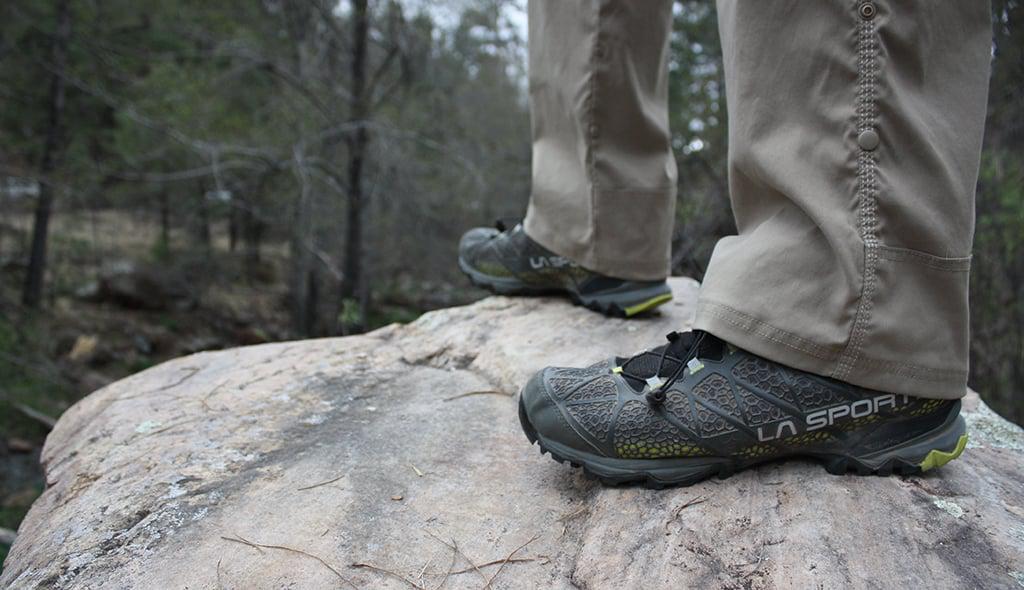 My parents were mountain people, and growing up on the Washington/British Columbia border, I had no choice but to become a mountain person as well. Our summers were filled with week-long backpacking trips through the North Cascades, freeze-dried meals, dirty backpacks, and farmers’ tans were more vacation staples than sand castles or summer dresses. The back porch sight of four pairs of leather boots, gleaming with their freshly applied sno-seal, is ingrained in my being, a sign that alpine meadow campsites and crevasse navigating behind my dad were in my near future. My parents were as old-school as they come — coming of age in the mountains in the ’70s, they only knew the classic technology of thick leather boots with a thick layer of waterproofing on top. Our boots might have been impermeable to the deep summer snow that we slogged through, but the shoes were heavy, and my prepubescent feet sweated incessantly inside. It wasn’t until I grew up and moved out of the house that my whole family seemed to get the memo at once: leather boots that keep snow out and seal sweat in are archaic - now you can have your waterproof and breathable cake and eat it, too. In the span of a year, we all switched to breathable, GORE-TEX brand hiking shoes. First off, some clarifications. When deciding on a hiking shoe, there many considerations to be made: breathability, waterproofing, durability, and weight being four major criteria. Up until recently, it has been a challenge to find the right balance of all of these vital characteristics in one shoe. When I was a child, we sacrificed breathability for waterproofing and durability. Now, as an adult, I’ll sometimes sacrifice waterproofing and durability for breathability and weight savings. The innovations of GORE-TEX brand, however, have made these decisions practically obsolete; it is now possible to have breathability, waterproofing, and durability in the same lightweight shoe.
My parents were mountain people, and growing up on the Washington/British Columbia border, I had no choice but to become a mountain person as well. Our summers were filled with week-long backpacking trips through the North Cascades, freeze-dried meals, dirty backpacks, and farmers’ tans were more vacation staples than sand castles or summer dresses. The back porch sight of four pairs of leather boots, gleaming with their freshly applied sno-seal, is ingrained in my being, a sign that alpine meadow campsites and crevasse navigating behind my dad were in my near future. My parents were as old-school as they come — coming of age in the mountains in the ’70s, they only knew the classic technology of thick leather boots with a thick layer of waterproofing on top. Our boots might have been impermeable to the deep summer snow that we slogged through, but the shoes were heavy, and my prepubescent feet sweated incessantly inside. It wasn’t until I grew up and moved out of the house that my whole family seemed to get the memo at once: leather boots that keep snow out and seal sweat in are archaic - now you can have your waterproof and breathable cake and eat it, too. In the span of a year, we all switched to breathable, GORE-TEX brand hiking shoes. First off, some clarifications. When deciding on a hiking shoe, there many considerations to be made: breathability, waterproofing, durability, and weight being four major criteria. Up until recently, it has been a challenge to find the right balance of all of these vital characteristics in one shoe. When I was a child, we sacrificed breathability for waterproofing and durability. Now, as an adult, I’ll sometimes sacrifice waterproofing and durability for breathability and weight savings. The innovations of GORE-TEX brand, however, have made these decisions practically obsolete; it is now possible to have breathability, waterproofing, and durability in the same lightweight shoe.
GORE-TEX brand innovations
GORE-TEX brand blew the world of outdoor fabric out of the water back in 1976 when it received its first commercial order for GORE-TEX fabric — the first breathable, waterproof, and windproof fabric. The company has been innovating ever since, and no fabric has come close to their level of performance. This fabric has been put into use on everything from jackets and pants, to gloves and hats, to footwear. If you’re curious to learn more, GORE-TEX brand has put together a series of videos explaining their advanced technology, like the breathability video below. Each new GORE-TEX brand prototype is tested extensively to ensure that it is waterproof, breathable, and not lacking in durability. In the Walking Simulator, test shoes are placed on foot-shaped forms with water sensors, and then subjected to 200,000 steps in a tub of water. The water sensor indicates if water ever enters the shoe; testers then modify the shoe and submit it for another round of testing. This cycle repeats itself until the shoe can withstand 200,000 steps in water without the sensors being triggered. Next is the Wicking Test, in which non-GORE-TEX brand materials used in the upper — from leather to foam, to stitching and laces — are tested to ensure that they are non-wicking. In this way, water cannot be transported into the shoe over the impermeable GORE-TEX liner. Boots then go through the Centrifugal Tester, in which they are filled with water and spun at high speeds. The pressure from the spinning forces water through even the smallest holes, allowing testers to discover leaks in the membranes. Lastly, each shoe undergoes a Comfort Test, in which the tester ensures that all of the components — GORE-TEX membrane and all other materials — are working together to provide comfortable and high-performance breathability throughout the entire shoe.
Breathability
It doesn’t take much convincing to understand why a breathable hiking shoe is the most high-performance option for trekking. If you’re still dubious, here are some reasons why it’s a great choice:
- having wet, swampy feet due to sweat can cause trenchfoot
- wet socks increase your chances for blisters
- wet feet can quickly become cold feet
- would you really opt for sweaty feet if you didn’t have to?
Your breathable hiking shoes in action
All across the U.S. and internationally, conditions lend themselves to situations in which you’d want your feet to stay dry from both the outside and the inside. Here, we break down the different regions of the country and the weather conditions that could benefit from the functionality of breathable hiking shoes.
Northeast
Northeast weather certainly knows its extremes, from muggy summers to cold and snowy winters. In the summertime, your feet are already prone to sweat, even before stuffing them in a shoe and forcing them to hike on a trail; a breathable hiking shoe would be absolutely essential to your comfort and foot health. In the wintertime and shoulder seasons, you’ll likely find a lot of moisture on the trail, or even on the city sidewalk, whether it be snow or melting snow. A solid hiking shoe with a waterproof and breathable membrane will be your high-performance choice on this terrain, whether you’re enjoying a springtime hike or walking to the corner store.
Midwest
Similarly to the Northeast, Midwest summers can be very warm and humid. Even if you’re forgoing a hike for a day at the lakefront or farmers’ market, a breathable walking shoe will be the next best thing to sandals in the summer months. The wintertime can be snowy and wet, and again a hiking shoe with a waterproof and breathable membrane will be your top choice, especially for high-output activities such as snowshoeing or capturing a fresh snowfall for your outdoor photography hobby.
West
The Pacific Northwest and the Mountain West are both known for their alpine environments, but whether you’re up in the mountains or down in the forest, summers will be warm, and you’ll likely be covering a great deal of terrain. For high-output activities such as approaching a rock climb, alpine scrambling, or geocaching, a breathable hiking boot will get you to your destination without soggy, sweaty feet. In the wintertime, whether you’re snow camping in the backcountry or bike commuting, your high output in moderate to cold temperatures will generate heat in your feet that can escape in breathable hiking shoes.
Southwest
The Southwest is one of the few parts of our country that is consistently dry. Because of this, it is consistently sunny, and warm temperatures can be found in this region year-round. Whether you’re planning for a spring backpacking trip in Canyonlands National Park, car camping in Arches National Park, or mountain biking to Moab, you’ll want a breathable hiking shoe to mitigate overheating of your feet.
Southeast
The Southeast is the land of humid summers and moderately cool winters, where trails are always accessible and the people always friendly. Whether you’re birdwatching on Sanibel Island, canoeing in a Louisiana bayou, or attending one of the many annual summertime music festivals, your feet are bound to be working and generating heat. With a breathable shoe, that heat will have an escape path, and your feet will stay comfortable and dry.





